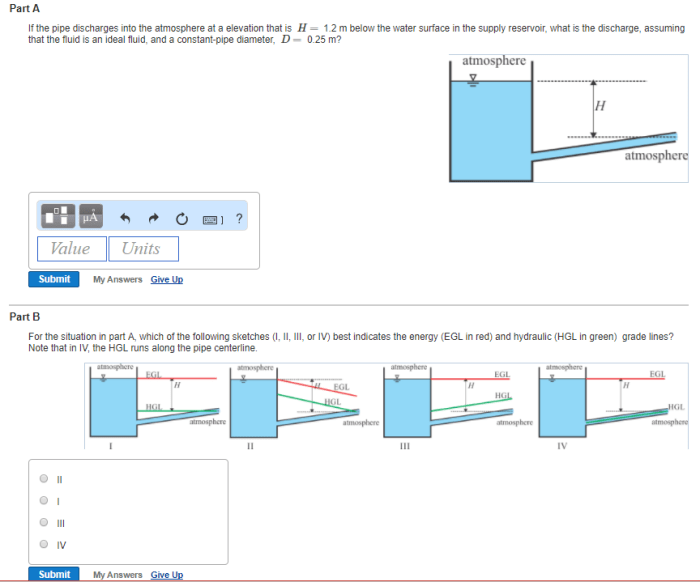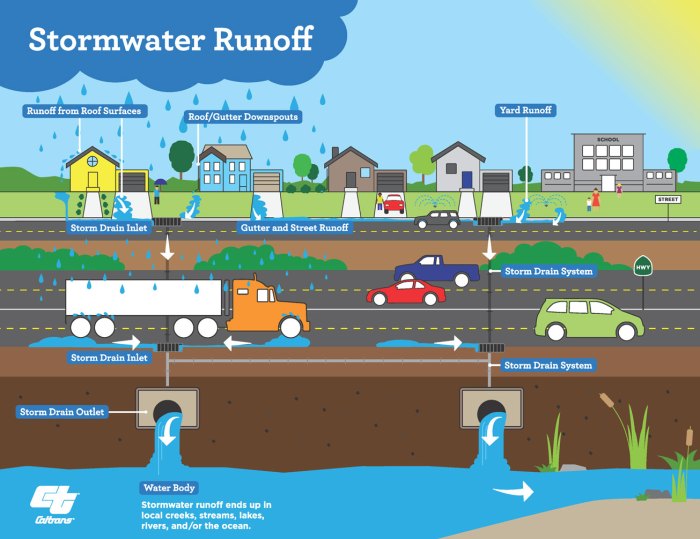A pipe discharges stormwater into a creek, a common sight in urban and suburban areas. This stormwater discharge plays a crucial role in managing excess rainwater and preventing flooding. However, it also raises concerns about potential environmental impacts. This article delves into the details of stormwater discharge, exploring the components, purpose, and environmental implications associated with this practice.
Stormwater discharge systems are designed to collect and convey stormwater runoff from impervious surfaces, such as roofs, roads, and parking lots. These systems typically consist of pipes, culverts, and other infrastructure that direct stormwater to nearby creeks, rivers, or other water bodies.
Understanding the process and impact of stormwater discharge is essential for effective stormwater management and maintaining healthy aquatic ecosystems.
Stormwater Discharge: A Pipe Discharges Stormwater Into A Creek

Stormwater discharge refers to the process of releasing excess rainwater and runoff from urban and developed areas into natural water bodies, such as creeks and rivers. This discharge can occur through a variety of means, including pipes, culverts, and open channels.
The components involved in stormwater discharge systems typically include:
- Inlets: Structures that collect stormwater runoff from streets, parking lots, and other impervious surfaces.
- Pipes: Conduits that convey stormwater runoff from inlets to discharge points.
- Outfalls: Structures that release stormwater runoff into receiving waters.
The primary purpose of stormwater discharge systems is to manage excess stormwater runoff and prevent flooding in urban areas. These systems help to convey stormwater away from sensitive areas, such as buildings and infrastructure, and into natural water bodies.
Pipe Infrastructure
The types of pipes used for stormwater discharge vary depending on the specific requirements of the system. Common materials include:
- Concrete: Durable and resistant to corrosion, but heavy and difficult to install.
- Corrugated metal: Lightweight and easy to install, but susceptible to corrosion.
- Polyethylene: Flexible and resistant to corrosion, but can be more expensive than other materials.
Design considerations for stormwater discharge pipes include:
- Pipe diameter: Determined by the volume of stormwater runoff expected.
- Pipe slope: Ensures proper flow of stormwater and prevents clogging.
- Pipe material: Selected based on factors such as durability, corrosion resistance, and cost.
Maintenance and inspection procedures for stormwater discharge pipes are crucial to ensure proper functioning and prevent blockages. Regular inspections involve:
- Visual inspections: To identify any visible damage or blockages.
- Camera inspections: To assess the condition of the pipe interior and identify any potential issues.
- Flow monitoring: To ensure adequate capacity and prevent overflows.
Environmental Impact
Stormwater discharge into creeks can have potential environmental impacts, as it may carry pollutants collected from urban surfaces. These pollutants can include:
- Sediment: Can clog waterways and damage aquatic habitats.
- Nutrients: Can cause algal blooms and eutrophication.
- Toxic chemicals: Can harm aquatic life and human health.
Regulations and best practices exist to mitigate the environmental impact of stormwater discharge. These include:
- Stormwater management plans: Developed to identify and implement measures to control stormwater runoff and reduce pollution.
- Low impact development (LID) techniques: Designed to minimize stormwater runoff and promote infiltration.
- Green infrastructure: Incorporates natural elements, such as rain gardens and bioswales, to treat stormwater and reduce pollution.
Water Quality Monitoring
Water quality monitoring is essential for assessing the impact of stormwater discharge on creeks. Parameters typically monitored include:
- Turbidity: Measures the cloudiness of water, indicating the presence of suspended solids.
- pH: Indicates the acidity or alkalinity of water, which can affect aquatic life.
- Dissolved oxygen: Measures the amount of oxygen available in water, which is crucial for aquatic respiration.
Water quality sampling and analysis methods involve:
- Grab sampling: Collecting a single sample at a specific time and location.
- Composite sampling: Combining multiple samples over a period of time to obtain a representative average.
- Laboratory analysis: Conducting chemical and biological tests to determine the presence and concentration of pollutants.
Case Studies and Examples, A pipe discharges stormwater into a creek
Successful stormwater discharge management has been demonstrated in various case studies and examples. Innovative technologies and approaches include:
- Permeable pavements: Allow stormwater to infiltrate into the ground, reducing runoff and pollution.
- Rainwater harvesting systems: Collect and store rainwater for reuse, reducing stormwater discharge.
- Bioretention basins: Engineered depressions filled with plants and soil that filter and treat stormwater.
Real-world examples of the impact of stormwater discharge on creek ecosystems include:
- Increased sedimentation: Can clog fish spawning grounds and reduce habitat quality.
- Nutrient enrichment: Can lead to algal blooms and eutrophication, harming aquatic life.
- Toxic contamination: Can accumulate in aquatic organisms and pose risks to human health.
Future Trends and Research
Emerging trends in stormwater discharge management include:
- Green infrastructure: Increasing adoption of natural and sustainable approaches to stormwater management.
- Smart stormwater systems: Utilizing sensors and technology to monitor and control stormwater discharge in real-time.
- Adaptive management: Implementing strategies that can adjust to changing climate and land use patterns.
Areas for further research and development in stormwater discharge systems include:
- Improved monitoring techniques: Developing more accurate and cost-effective methods for monitoring stormwater quality.
- Innovative treatment technologies: Exploring new and efficient ways to remove pollutants from stormwater runoff.
- Climate change impacts: Assessing the potential effects of climate change on stormwater discharge and developing adaptation strategies.
FAQ Guide
What is the purpose of stormwater discharge systems?
Stormwater discharge systems are designed to collect and convey excess rainwater from impervious surfaces to prevent flooding and manage stormwater runoff.
What are the potential environmental impacts of stormwater discharge into creeks?
Stormwater runoff can carry pollutants such as sediment, nutrients, and bacteria into creeks, potentially affecting water quality and aquatic ecosystems.
How is water quality monitored for stormwater discharge?
Water quality monitoring involves sampling and analyzing stormwater runoff to assess the presence of pollutants and ensure compliance with environmental regulations.


